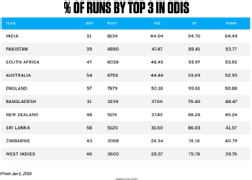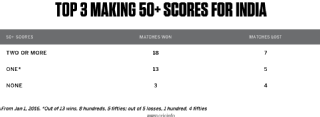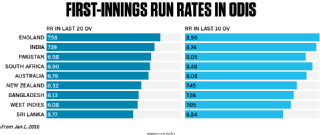|
In the last few years, India's 50-over success has been scripted by their top three. Rohit Sharma, Shikhar Dhawan and Virat Kohli are among the finest top-order batsmen in 50-overs cricket. All of them have the ability to negate the new-ball threat (in all conditions) and bat deep into the innings, once set. Since 2016, in 51 matches they have made nearly 65% of the total runs scored by India in ODI cricket. Pakistan's top three are second best on this metric, with 54%. India's top three also average 64 runs per match between them, while England's top three, the second best in this regard, average 50 runs.  When one or two of the top three scores 50-plus each for India, the team's win percentage shoots up to over 70%. And when none of them do, India lose 57% of their matches (four out of seven). This underlines these batsmen's influence on the outcome of India's ODI matches. It amounts to an over-reliance on them that must be addressed before the World Cup starts next year.  Very often India's top three take the team total to 170 runs in the first 30 overs but still India seldom end with 325-plus after 50 overs. India's batting moves at almost the same pace right through the course of 50 overs, and while they still manage to make enough runs to beat most opponents, it feels like they are underachieving, since the stage seemed set for them to score 20-30 runs more. While Kohli's absence considerably weakens the team, it also provides one final opportunity to identify the players who can be persisted with to solve the middle-order question ahead of the World Cup. In order to fulfil this objective, the selectors must not try to fill Kohli's spot with an opener, because that's not the area of concern; ideally, they should pick someone who is in the running for the No. 4 spot in the XI.  Here's a possible playing XI that can look to address some long-term problems.
Here's a possible playing XI that can look to address some long-term problems.
Rohit and Dhawan at the top
There's no argument about these two opening. Not only do both complement each other, they are also runaway match-winners in their own right. Just that in Kohli's absence, they won't have the luxury to be too adventurous at the start of the innings, for one of them must bat till the 30th over. Also, it'll be interesting to see if their approach changes significantly when there isn't the cushion of Kohli walking out at 3. Ambati Rayudu at three, Dinesh Karthik at four
Rayudu averages 50 in ODI cricket, and that in isolation must make you wonder why he was dropped in the first place. But a closer look at the stats will tell you that the average is inflated because of the number of times he has remained unbeaten. The fact that his strike rate is 76 and not in the high 90s isn't ideal for someone batting lower down the order. His impressive IPL returns brought him back into contention, but it shouldn't be lost on the team that the majority of those runs came as an opener. He has improved his attacking play against pace in addition to his competence against spin. But since he isn't your ideal finisher, it would be wise to let him audition for a place in the middle order by batting him in Kohli's place. Karthik has been around forever but the consensus is that he hasn't batted as well as he is batting now, and though he has managed to finish some games in T20 cricket, it might be ideal to keep him as an option for No. 4. Like Rayudu, he is also a touch player, and that's never ideal for someone who bats regularly in the last ten overs. MS Dhoni at five
In Kohli's absence, there's more focus on Dhoni's role and responsibility of not just holding the middle order together but also finishing some games. While his IPL returns suggested that he has turned back the clock, the limited-overs leg of the England tour hinted otherwise. I'd like him to bat at five and use the Asia Cup to find a role that's best suited for him at this stage of his career. Dhoni has been vocal about his preference for batting at four, but having your most experienced players in the top four positions is a disaster waiting to happen. Also, batting in the lower order, against the old ball and with fewer field restrictions, is the tougher pursuit in ODI batting, and it would be grossly unfair to have only the younger lot lift that load. Kedar Jadhav at six, Hardik Pandya at seven
These are the two allrounders who need to bowl a few overs and play the role of finishers. For the longest time, India went in with only five bowling options - Pandya being the fifth. But while his bowling has improved, he's not your ideal fifth bowler in any white-ball cricket. Even Mumbai Indians have him as one of six options. Also, not having a sixth bowling option doesn't allow you a cushion if one of the lead five has a bad day, which happens every now and then. Jadhav's style of bowling ought not to work in international cricket (it doesn't in List-A and IPL either), but somehow it does in ODIs. He has taken 19 wickets in 130 List-A matches and 16 of those have come at the highest level. His batting isn't all about power, which is considered a must to succeed in the last ten overs, but somehow he has made that work too. The rest
Playing four bowlers, Bhuvneshwar Kumar, Jasprit Bumrah, Kuldeep Yadav and Yuzvendra Chahal, is a straightforward choice, but Bumrah's workload will need to be monitored right through the tournament. He bowled a lot of overs in the three Tests he played in England, and the heat of the UAE will be unrelenting. It would be wise to play Khaleel Ahmed in both league games. Also, playing Axar Patel in place of Kuldeep or Chahal in the opening game against Hong Kong wouldn't be a bad option, for he's unlikely to get too many games leading up to the World Cup.
|

